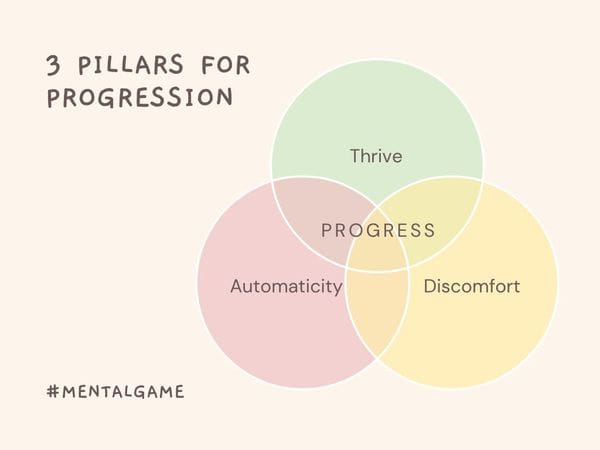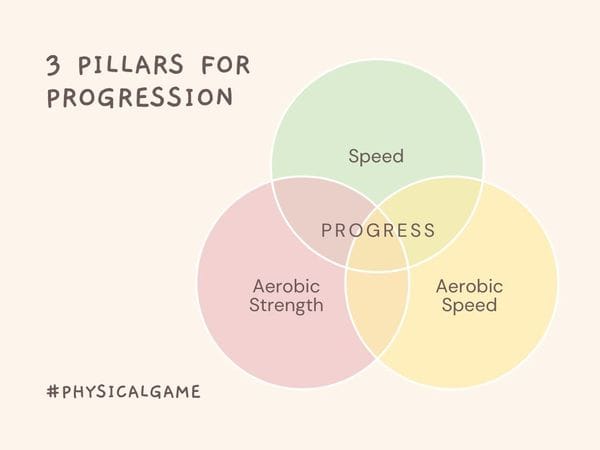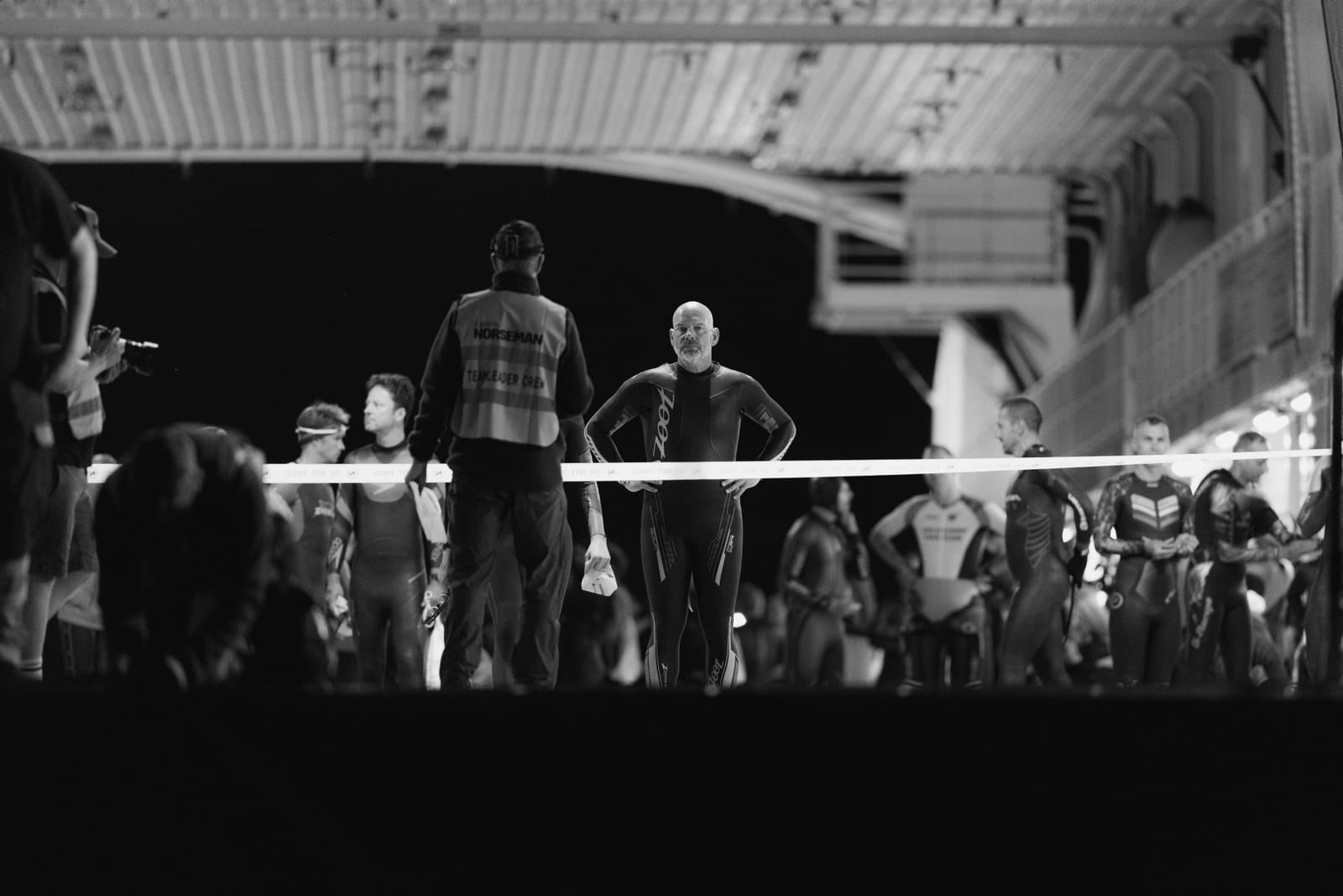Athletes often focus primarily on physical training, yet the mental aspects of sports are equally crucial for peak performance. The concepts of Thrive and Automaticity, along with understanding the psychological nature of discomfort, play pivotal roles in an athlete's journey.
Many athletes struggle with maintaining consistency, adapting to change, and managing discomfort. These challenges can hinder their ability to perform at their best.
How can athletes integrate the principles of consistency, adaptability, resilience, and automaticity into their training to not only overcome these challenges but also thrive in their sport?
To thrive in sports, athletes need to prioritise consistency in their training, embracing it as the core of their practice. This consistency lays the groundwork for adaptability - the ability to adjust to new challenges and conditions with agility. Resilience, or the capacity to learn from setbacks, is vital in this process. Alongside, mastering technique and keeping strategies simple ensures long-term success. A data-driven approach that focuses on aerobic strength and a personalised training regimen also contribute to thriving in sports.
Additionally, embracing positive anxiety and developing muscle memory through focused training enhances an athlete's automatic responses during competition. Understanding and managing the psychological aspects of discomfort, such as differentiating feeling from overthinking and accepting pain as part of the process, further strengthen an athlete's mental resilience. This comprehensive approach enables athletes to not only perform effectively but also develop a deeper connection with their sport and themselves.

The Thrive pillar emphasises the importance of developing a holistic and adaptable approach to training and competition. By focusing on consistency, adaptability, resilience, and mastering the basics, athletes can elevate their performance to new heights, not just surviving but thriving in their sport.
This concept goes beyond mere survival or coping on the sporting field. It's about cultivating a mindset and approach that propels you towards consistent, adaptable, resilient, and fundamentally strong performances.
Consistency: The Bedrock of Success
Prioritizing Consistency
Consistency isn't just a part of training; it is the core. Over time, consistent effort builds a strong foundation for success. Athletes are advised to prioritise actions that can be maintained consistently over those that offer short-term gains but are unsustainable.
Adaptability: The Art of Flexibility
Embracing Change
While consistency lays the foundation, adaptability allows athletes to navigate the ever-changing dynamics of their sport. It involves paying close attention to the training process and adapting to new challenges, conditions, and situations with agility.
Resilience: Overcoming and Learning
Learning from Setbacks
Resilience is the ability to bounce back from setbacks, be it a bad training session or a disappointing race. These experiences are invaluable lessons, teaching athletes how to improve and become stronger.
Mastery of Technique: Go Slow to Go Fast
Importance of Technique
Mastering technique is essential. Athletes are encouraged to learn and perfect movements at a slower pace to ensure they can maintain form and efficiency when moving fast. This approach is crucial for long-term development and injury prevention.
Simplicity: Cutting Through the Noise
The KISS Principle
Keeping training and strategies simple, focused, and free from unnecessary complications allows athletes to concentrate on what truly matters in their development.
Data-Driven Approach: The Screen
Intelligent Use of Data
While data from devices like Garmins or power meters is valuable, athletes should not become overly reliant on them. Data should inform, not dictate, the training process.
Aerobic Strength: The Key to Endurance
Building Aerobic Capacity
Developing aerobic strength and speed is crucial. The aim is to improve the body's efficiency - going faster at a lower oxygen cost, which is a vital aspect of thriving in endurance sports.
Individualised Approach: Fit it to You
Personalising Training
Each athlete is unique, and their training should reflect their individual needs, strengths, and weaknesses. Instead of following others’ paths, focus on what works best personally.
Goal Setting: You Can Get It, If You Let It
Realistic and Positive Goal Setting
Setting realistic goals and maintaining a positive mindset about achieving them is vital. Focusing on capabilities rather than limitations encourages growth and progression.
Relaxation: Embrace the Challenge
The Power of Relaxation
Learning to relax into discomfort, challenge, and even pain is a skill that athletes should cultivate. This practice is as much a part of training as physical conditioning, playing a key role in thriving under pressure.

Automaticity: The Core of Athletic Mastery
The concept of automaticity stands as a cornerstone for peak performance. This multifaceted approach goes beyond mere physical preparation, weaving together mental and physical disciplines that are crucial for any athlete aspiring to reach their potential. From the nuanced specificity of training regimens to the foundational building of trust in one's abilities, automaticity is about harmonising the body and mind to act as a cohesive, high-performing unit.
Central to this concept is the management of anxiety, a common yet often underestimated hurdle in the athlete's journey. Equally important is the development of muscle memory, where repeated, focused practice transforms complex actions into seamless, almost reflexive responses. However, automaticity is not just about the body's physical response; it delves deeper into the psyche of the athlete.
At its core, it nurtures a mental game marked by presence, a state of heightened awareness and focus during both training and competition. It fosters a sense of non-reactivity, enabling athletes to maintain equilibrium in the face of intense pressure or unexpected challenges. Moreover, it underscores the significance of establishing positive rituals, which provide a sense of stability and consistency amidst the rigours of athletic pursuit.
All these elements come together to forge an athlete who is not just physically adept but also mentally equipped to navigate the complex, often unpredictable landscape of competitive sports. As we delve deeper into the realms of automaticity, we uncover its pivotal role in shaping athletes who are ready to excel, not just in their chosen sport, but in the holistic sense of personal and professional development.

The Principle of Practice
You Are What You Practice
Automaticity in athletics is deeply rooted in the consistent practice that shapes an athlete's performance. This principle advocates for a holistic approach, where both physical and mental aspects of training are aligned with realistic performance goals, steering clear of any unrealistic expectations or fantasies.
Specificity in Training
Training with a specific purpose allows athletes to focus their efforts on scenarios they are likely to encounter in competition. This targeted approach ensures that every element of their training is directly relevant to their performance goals, enhancing the effectiveness of their preparation.
Trust: The Foundation of Automaticity
Building Trust in Your Body
The ability to trust one's body to replicate practiced patterns is crucial. This trust forms the foundation for effective application of training in competitive scenarios. Without it, there's a risk of failing to translate training into actual performance.
The Role of Trust in Performance
Moving from trust to thrust involves using the confidence gained from training to enable peak performance under pressure. Trust in training translates into effective action, particularly in high-stress competitive environments.
Instincts: Automaticity in Action
Racing on Instinct
Champion athletes often excel by relying on instincts honed through rigorous training. This instinctive performance is the culmination of automaticity in both their physical and mental responses, allowing them to react swiftly and effectively during competition.
Freeing Mental Capacity
By trusting their trained instincts, athletes can allocate more mental resources towards strategic aspects of performance and tapping into their inner drive and motivation, crucial for excelling in competitive situations.
Managing Anxiety Through Automaticity
The Trap of Overthinking
Athletes are encouraged to trust their training and avoid overthinking, which can lead to performance anxiety. This trust is key to reducing unnecessary stress and enhancing focus during competitions.

Harnessing Positive Anxiety
Positive anxiety, when harnessed correctly, can be a powerful tool for athletes. It can be transformed into energy that enhances focus and drive, rather than acting as a hindrance to performance.
Muscle Memory: The Symbiosis of Body and Mind
Integrating Physical and Mental Training
Muscle memory is a fusion of physical training and mental focus. This synergy is crucial for achieving automaticity, where actions become instinctive and seamless.
Developing Consistent Movement Patterns
Athletes should concentrate on internalising movement patterns during training to make them natural and automatic in competitive situations, thereby enhancing performance efficiency.
The Power of Presence in Training
Staying Present for Effective Training
The quality of an athlete's presence during training is more significant than the quantity of training. Being mentally present ensures deeper internalization and effectiveness of the training process.
Training with Full Attention
Maximizing the impact of training requires full focus and attention from the athlete. The more engaged and present an athlete is during training, the more naturally these patterns will manifest during competition.
Mental Patterns: Preparing the Mind for Competition
Training the Mind
Observing and adapting mental patterns during training is crucial, as these patterns are likely to surface in competitive scenarios. This awareness allows for better mental preparation and strategy.
Preparing for Mental Challenges
Developing positive mental patterns in training equips athletes to handle the mental challenges of competition, enhancing their mental resilience and ability to cope with stress.
Non-Reactivity: A Key to Mental Stability
Cultivating Non-Reactivity
Practicing non-reactivity during training is vital for athletes to maintain their composure in high-pressure situations during a race, helping them to stay calm and focused.
Training for Mental Equilibrium
Balancing emotions with performance through non-reactivity training is a valuable asset for athletes. It allows them to maintain focus and equilibrium, even in the face of intense internal impulses.
Rituals: Enhancing Automaticity Through Consistency
The Power of Rituals
Creating and maintaining positive rituals in training can establish a focused and positive mental environment, significantly enhancing the quality and effectiveness of the training.
Consistency and Routine
Establishing consistent rituals in training helps in building reliable patterns, which can have a positive impact on an athlete's performance by providing stability and predictability in their routine.

The Psychological Nature of Discomfort
Incorporating strategies that address the psychological aspects of discomfort into training and competition can revolutionise an athlete's approach to pain. This shift in focus from mere avoidance to a deeper understanding and acceptance transforms discomfort from a barrier into a tool for building strength and resilience. This mental evolution not only enhances an athlete's performance but also fosters a more profound and introspective relationship with sport and yourself.
Understanding the Mind-Body Connection
Discomfort in sport transcends the physical realm, delving into how mental perception shapes the experience. The way athletes interpret and mentally manage discomfort has a significant impact on their overall performance and endurance.

Understanding the Mind-Body Connection
Discomfort in athletics transcends the physical realm, delving into how mental perception shapes the experience. The way athletes interpret and mentally manage discomfort has a significant impact on their overall performance and endurance.
Identity and Mindfulness
Differentiating Feeling from Thinking
Encouraging athletes to experience discomfort directly, rather than getting entangled in their thoughts about it, can help reduce the intensity of discomfort. This approach emphasizes the importance of being more mindful and present with physical sensations, avoiding the magnification of pain through mental over-analysis.
Relaxing into Pain
Integrating relaxation techniques in various aspects of training helps athletes manage discomfort more effectively. This practice teaches them to maintain composure and focus during physically challenging situations, enhancing their ability to perform under pressure.
The Power of Positivity
Smiling Through Challenges
The simple act of smiling can trigger positive changes in the nervous system, reducing stress and conserving energy. This neurological response can be a powerful tool for athletes, helping them face challenges with a more positive and resilient mindset.
Overcoming Mental Resistance
Controlling the Urge to Escape
The instinct to mentally escape from challenging or painful situations is common among athletes. Recognizing and managing this impulse is crucial for maintaining focus and effectively handling discomfort during training and competitions.
Reassessing Pain Perception
Understanding and Adapting to Pain
Changing how one perceives and responds to pain can dramatically alter the experience. This involves confronting and reframing the pain, rather than being in denial or resisting the reality of the present situation.
Developing Tolerance
Expanding Comfort Zones
Building tolerance to discomfort is a process of gradual exposure and staying present with challenging sensations. This approach helps athletes extend their comfort zones, enhancing their ability to endure and perform under stress.
Breaking Pain Associations
Overcoming Past Pain Memories
Athletes need to consciously avoid linking current discomfort with past negative experiences. This detachment helps prevent the formation of fear and doubt that could hinder performance.
Acceptance as a Tool for Change
Embracing Discomfort
Accepting discomfort is the first step in teaching the brain to reassess its perception of pain and danger. This acceptance plays a pivotal role in changing the athlete's experience and response to pain.
Avoiding Negative Judgments
The Impact of Negative Thinking
Athletes are encouraged to steer clear of negative judgments about external conditions, competitors, or themselves. These judgments can intensify discomfort, leading to increased mental strain and suffering.
Losing Duality
Focusing on the Process
By eliminating the perceived conflict or duality with external factors, athletes can manage discomfort more effectively. This mindset helps them focus solely on their process, allowing them to navigate pain and discomfort with greater ease and efficiency.








